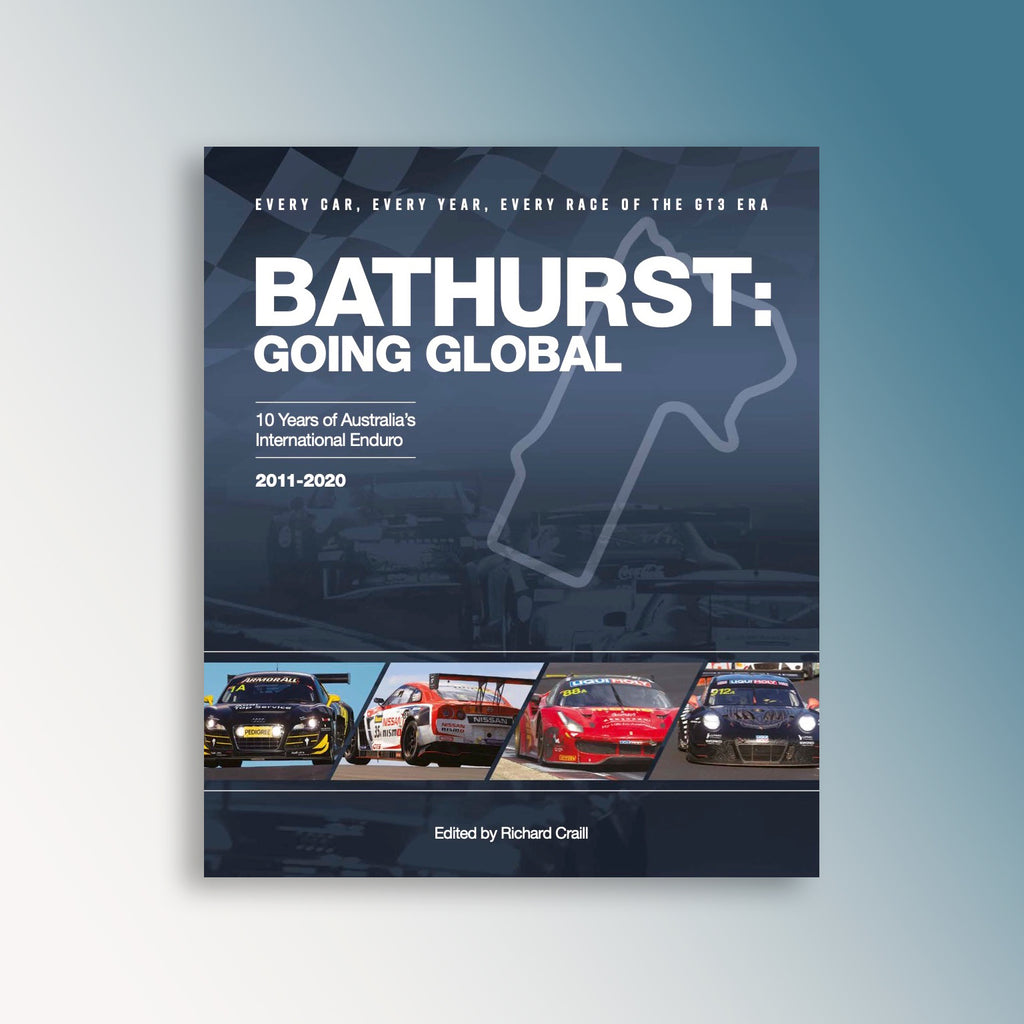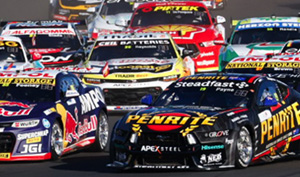VALENTINO Rossi would follow in some illustrious footsteps if, as reported by News Corp, he makes his Mount Panorama debut on four wheels at the 2023 Liqui Moly Bathurst 12 Hour.
There are no shortage of two-wheel enthusiasts and former competitors that have tackled Mount Panorama previously – former junior motorcrossers Neil Crompton and Brad Jones come to mind.
However, a large number of riders that raced and won at world championship level also have at least one Bathurst car race on their CVs.
Gregg Hansford
Hansford is unique on this list as having wins at Mount Panorama on both two and four wheels.
His first triumphs at Mount Panorama came at the traditional Easter bike meetings before shifting his sights on the world championship, where he claimed 10 Grand Prix wins for Kawasaki in the 250cc and 350cc classes between 1978-79 before injuries curtailed his two-wheel career.
Hansford soon switched full-time to four wheels, recruited by Allan Moffat to share his Mazda RX-7s and Ford Sierras. They won the 1988 Sandown 500 and nearly captured that year’s Bathurst 1000 before mechanical woes forced them out with just 32 laps to go.
He finally etched his name in Bathurst’s four-wheel record books in 1993, co-driving a Commodore with Larry Perkins to victory in that year’s Tooheys 1000, then backed it up with a win in the James Hardie 12 Hour production car enduro just a few months later.

Johnny Cecotto
A contemporary of Hansford’s on two-wheels, the Venezuelan claimed the 350cc world title in 1975 at age 19, setting a record for the youngest motorcycle world champion that stood for 15 years.
He also triumphed in the prestigious Daytona 200 in 1976 and won three 500cc Grand Prix across the 1977 and 1978 seasons, but retired from motorcycle racing at just 24 years of age in order to pursue a career in car racing.
Cecotto made it all the way to Formula 1, where he was teammate to Ayrton Senna at Toleman in 1984, until a horror shunt in qualifying for the British Grand Prix at Brands Hatch left him with leg injuries that curtailed his open-wheel career.
Instead he turned his attention to touring cars, securing a role as a factory BMW driver that brought him to Mount Panorama on three occasions – expressing his surprise on his first visit that anyone would even consider racing a motorbike around the circuit!
Cecotto finished second alongside Roberto Ravaglia on debut in 1985, put his BMW M3 into the Top 10 Shootout at the 1987 World Touring Car Championship round on his way to seventh with Gianfranco Brancatelli, and finished fourth with Tony Longhurst in 1992 despite crashing their M3 in the morning warm-up.

Wayne Gardner
Gardner was arguably the highest-profile Australian racer to go from two wheels to four.
He rode motorcycle racing into the mainstream in the 1980s, his 1987 500cc World Championship leading to Australia getting its own world title round in 1989 – which Gardner won in typically dogged, emotional fashion.
Although further world titles eluded him, Gardner remained a regular winner until his retirement from the 500cc series at the end of the 1992 season.
He tackled Mount Panorama in a car for the first time that same year, making his Bathurst 1000 debut in a privateer Commodore before joining the Holden Racing Team full time in 1993.
A decade-long career driving for both his own Wayne Gardner Racing team and others never quite led to success in the ‘Great Race’, although he finished third in the 1993 and 1995 races and claimed pole position in 2000 by topping a rain-hit Top 10 Shootout.

Troy Bayliss
Bayliss is one of a host of successful racers to briefly try four-wheel racing after their two-wheel careers ended.
His storybook rise from club racer to multiple World Superbike Champion and MotoGP race winner was incredible, but it also includes a couple of motorcycle races at Mount Panorama in the early 1990s as a support event to the James Hardie 12 Hour.
Bayliss told the story of his career to the V8 Sleuth Podcast back in 2019 – listen in the player below!
After retiring from motorcycle racing at the end of his championship-winning 2008 WorldSBK season, Bayliss became the most recent two-wheel champion to race in the Bathurst 1000, pairing with Dean Fiore in the 2009 race.

Kunimitsu Takahashi
Takahashi might not be the highest-profile name on this list, but the Japanese legend enjoyed a groundbreaking career in motorsport.
A motorcycle racer in his teens, he joined the factory Honda team at the turn of the 1960s and was one of their first riders at world championship level. In 1961, he won the West German 250cc Grand Prix at Hockenheim, taking Honda’s second victory in a world championship race and becoming the first Japanese rider to win at that level.
Like Cecotto, he retired from two-wheel racing at age 24 and switched to cars, enjoying a career that included a Formula 1 start in the 1977 Japanese Grand Prix, a host of Le Mans 24 Hours tilts through the Group C and GT eras, as well as touring car racing.
It was the latter that brought him to Mount Panorama in the mid-1960s as a driver for the factory Datsun squad. Paired with Moto Kitano, Takahashi won Class A in the 1966 Gallaher 500 and made two further starts in the ‘Great Race’.
His greatest contribution to motorsport? Takahashi, who sadly passed away aged 82 in March, is regarded as the father of the sport of drifting.

Michael Dowson
Dowson is the only racer alongside Hansford in this list that has been victorious on both two and four wheels at Mount Panorama.
A contemporary of Kevin Magee and Mick Doohan, Dowson didn’t quite get the international breaks that his Marlboro Yamaha teammates had. Nevertheless, Dowson was a winner at the annual Easter bike races at Bathurst in the 1980s, won a pair of World Superbike Championship races and was successful in the domestic championships in both Australia and Japan.
He was one of a handful of racers from various levels and disciplines selected to race a Toyota Team Australia Corolla by the manufacturer’s ‘Star Search’ program.
While he crashed out early in Lakeside’s Australian Touring Car Championship round, Dowson claimed a class victory at that year’s Bathurst 1000 alongside future rally star Neal Bates.

Daryl Beattie
Beattie was one of a host of Australian riders to make it to the 500cc world championship in the wake of Gardner’s breakthrough success in 1987.
A rising star of the Australian scene, he headed to Japan in the early 1990s where victory in the All-Japan 500cc Championship led to him taking over a factory Honda seat in the world championship in 1993 after Gardner’s retirement.
Beattie won the German GP in his rookie full-time season, then took two more race wins for Suzuki in 1995 while battling Mick Doohan for the world championship, but a series of injuries the following year led to him retiring at the end of the 1997 season.
He carved out a successful TV and commentary career with Channel 10 after returning home, which led to a chance to have a test in one of Paul Morris’ V8 Supercars in 2002.
Beattie made his V8 race debut later that year, sharing an Imrie Motor Sport Commodore at the Queensland 500 and Bathurst 1000 enduros, but that was as far as his Supercars aspirations went.

Graeme Crosby
One of the most colourful racers of his era, ‘Croz’ rose to prominence through Superbike racing in the 1970s and was victorious in some of the most prestigious two-wheel races on the planet, including the Daytona 200, Suzuka 8 Hour and at the Isle of Man TT.
He translated that success into the world of 500cc racing; although he never quite cracked it for a Grand Prix win, Crosby claimed a slew of pole positions and podium finishes across the 1981 and 1982 seasons riding for Suzuki then Yamaha.
Despite finishing second in the championship in the latter season, Crosby abruptly quit racing at the end of the year having grown tired of the politics involved in racing and retired home to New Zealand.
Crosby was soon tempted back to the racetrack, albeit in a touring car rather than on a bike.
His four-wheel career was relatively short but also spectacular, his best – and only full-time – season coming in 1986 at the wheel of a Ross Stone-run Holden Commodore, when he proved fast enough to make the Top 10 Shootout for the 1986 James Hardie 1000.

Casey Stoner
A racer from a very young age, Stoner earnt his place as a legend of Australian motorsport with a pair of MotoGP world championship in 2007 and 2011 for Ducati and Honda respectively.
But, not unlike Crosby, Stoner grew tired of the politics within the sport and retired at the end of the 2012 season to spend more time at home with his family.
Part of that time at home in 2013 included a season in Supercars’ second-tier Dunlop Series driving a Red Bull-backed Holden run by Triple Eight.
The spotlight was well and truly on Stoner throughout his rookie season of car racing. Every one of his rookie mistakes garnered far greater scrutiny and headlines than would have been given to a driver of similar experience who didn’t happen to be a multiple MotoGP champion; unsurprisingly, Stoner elected not to carry on for a second season.
His best race result was a fifth placing in the final race of the Queensland Raceway round, although he was on for a better result in the Saturday afternoon race at Bathurst until he hit the wall at Reid Park on a late restart.

Kevin Schwantz
The lanky Texan had arguably the shortest stint of racing at Mount Panorama of the motorcycle champions on this list – and that’s if you call them races.
Schwantz was a meteoric star amid 500cc racing’s age of superheroes, regularly turning in swashbuckling rides that delivered either spectacular victories or equally spectacular crashes.
His world championship win in 1993 was bittersweet, coming in the same season his long-time rival Wayne Rainey sustained a career-ending injury.
Schwantz, realising his heart was no longer in the sport, retired mid-way through the 1995 season and turned his attention to racing cars both in his native United States as well as in Australia.
His NASCAR stint down under also included a trip to Mount Panorama for a pair of exhibition races in support of Bathurst’s 1996 Australian Touring Car Championship round.
While the big stock cars put more emphasis on ‘exhibition’ than ‘racing’, Schwantz finished seventh and fifth in the four-lap sprints amid a field that included Jim Richards, Brad Jones, John Faulkner and future multiple Thunderdome champion Kim Jane.






